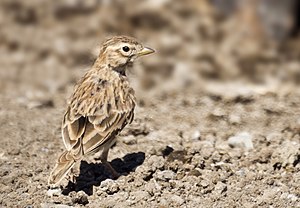Stub lark
| Stub lark | ||||||||||||
|---|---|---|---|---|---|---|---|---|---|---|---|---|

Stub lark |
||||||||||||
| Systematics | ||||||||||||
|
||||||||||||
| Scientific name | ||||||||||||
| Calandrella rufescens | ||||||||||||
| ( Vieillot , 1820) |
The Short-toed Lark ( Calandrella rufescens ) is a species of the family of larks (Alaudidae).
description
The 14 centimeter tall stub lark is similar to the short-toed lark , with which it occurs sympatric . In the Stummellerche about three ends of the hand wings are visible, while in the short-toed lark the wing covers completely mask the hand wings and only one or two ends of the hand wings can be seen. The Spanish form is also distinguished from the short-toed lark by the fine stripes on the front breast that can be seen up close. The small neck mark, which is sometimes visible in the short-toed lark, is missing in it. Their coloring is generally a little more brown and less red-brown.
voice
Their characteristic call "prrit" also occurs in singing. This is similar to the short-toed lark, but is more pleasant and persistent. The song is performed in an ascending spiral flight or in a high circling flight.
Occurrence
The Stummellerche inhabits wasteland, steppes and fields, but also dry peripheral areas in marshland. It breeds in southern and eastern Spain, on the Canary Islands, in northern and eastern Africa and from Asia Minor to Afghanistan. As a very rare stray visitor , she reaches the British Isles and Finland via Europe.
Way of life
Outside the breeding season, the stump larch forms large flocks in spring. It breeds on the ground in the thick grass, where the female lays two eggs in the nest made of fine material such as small leaves, roots, hair, wool and feathers. The young hatch after about 13 days and are fed with insects by both parents.
The Stummellerche can live up to five years.
Subspecies
- C. r. aharonii ( Hartert 1910) - Syria
- C. r. apetzii ( Brehm 1857) - Spain
- C. r. heinei ( Homeyer 1873) - Southern Russia and Kazakhstan
- C. r. minor ( Cabanis 1851) - North Africa
- C. r. nicolli ( Hartert 1909) - northern Nile delta
- C. r. persica ( Sharpe 1890) - Iran
- C. r. pseudobaetica ( Stegmann 1932) - from Armenia to south of the Caspian Sea
- C. r. polatzeki ( Hartert 1904) - Canary Islands
- C. r. Rufescens ( Vieillot 1820) - Canary Islands
- C. r. niethammeri ( Kumerloeve 1963) - Eastern Turkey
literature
- Hans-Günther Bauer, Einhard Bezzel and Wolfgang Fiedler (eds.): The compendium of birds in Central Europe: Everything about biology, endangerment and protection. Volume 2: Passeriformes - passerine birds. Aula-Verlag Wiebelsheim, Wiesbaden 2005, ISBN 3-89104-648-0 .
- Urs N. Glutz v. Blotzheim, KM Bauer : Handbook of the birds of Central Europe. Volume 10 / I: Passeriformes. 1st part: Alaudidae - Hirundinidae. AULA-Verlag, 1988, ISBN 3-923527-00-4 .
- Roger Peterson, Guy Montfort, FAD Hollom: Die Vögel Europäische , Verlag Paul Parey, Hamburg and Berlin, 9th edition 1966, ISBN 3-490-05518-7
Web links
- Age and gender characteristics (PDF; 1.6 MB) by Javier Blasco-Zumeta and Gerd-Michael Heinze (English)
- Calandrella rufescens onthe IUCN 2013 Red List of Threatened Species . Listed by: BirdLife International, 2012. Retrieved September 21, 2013.
- Feathers of the stump larch
Individual proof
- ↑ Bauer et al., P. 131

